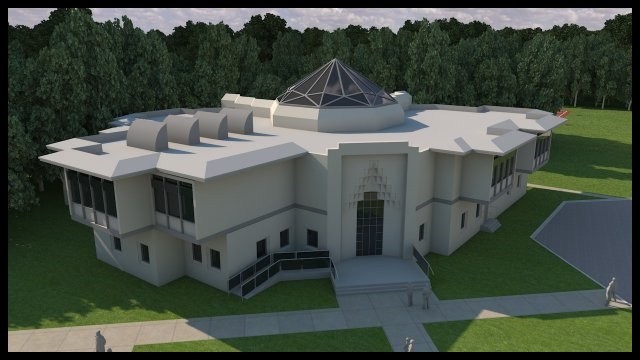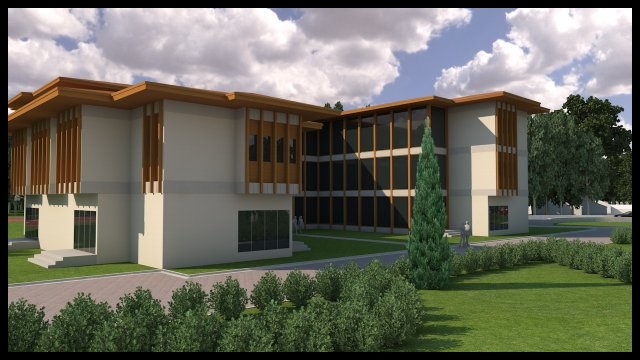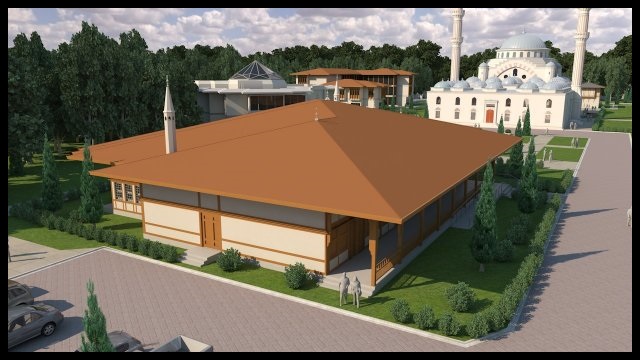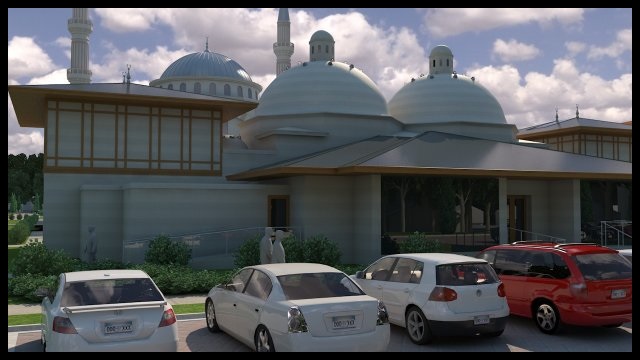Project Statistics
| GENERAL | Project Name |
A Campus Project Northeast US Owner (Identity Withheld) Design-Build Sept 2012 - Sept 2014 $69.5 million + $20 million allowance 308,000 SF |
||
| Building Sizes and Heights | ||||
|
20,600 GSF |
|||
| Project Team | ||||
|
Identity Withheld Balfour Beatty Construction Fentress Architects Hassa Capitol Development Design, Inc Arup USA, Inc Allen & Shariff The SK&A Group |
|||
| Occupancy Types | ||||
|
Assembly (A-1 & A-3) |
|||
|
||||
|
||||
| ARCHITECTURE | Cultural Center The focal point of the Cultural Center is the pointed glass dome at its center. The building circulates around this focal point with a round conference hall at the rear and an exhibition hall near the front as the main focuses. Portions of the second floor cantilever out from the wall, creating an undulating surface. The main entrance to the center features a large glass door and surrounding curtain wall, topped by ornamental stone. The roof is of simple flat design with a prominent cornice and pediment. Above the conference hall, the roof slopes down to accent the decline of the floor inside the hall. Four skylights bring light into the library on the second floor. Convent/Monastery The Convent Monastery is roughly U-shaped; one leg rises only two floors while the base and the other leg rise three floors. Similarly to the Cultural Center, portions of the second floor cantilever out slightly to create additional floor space. It also has a pronounced cornice to provide shading to the upper windows. Mosque Architecturally the Mosque is the focal point of the entire site project. It is the central building, the largest building, and the most impressive building. The main dome rises approximately 75 feet above the ground, already higher than any of the other buildings. The flanking minarets rise roughly 50 feet higher to a total of 127 feet. In front of the mosque is a large courtyard surrounded by an arcaded loggia. Smaller domes line the roof surrounding the courtyard and the main dome. A significant level of detail is put into the design of the mosque, which can be seen better in a picture that it can be described. Overall, the design has strong religious context and style indicative of mosques in the Middle East. Fellowship Hall The Friendship House is fairly simple in design. The east face features a fašade long loggia with wooden railings and arches. Two minaret shaped chimneys protrude above the roof, one at each end of the building. In a way, these mirror the much larger minarets of the mosque. Turkish Bath The Turkish Bath is roughly rectangular in shape. Lounges are located at either end of the above ground floors. These are marked on the exterior by square shape and hipped roof. Two domes, set side by side, rest in between the hipped roofs. Underneath these are the warm rooms of the bath. The front entrance is covered by an extensive dark colored roof, which contrasts the lighter color of the fašade. Two curtainwall systems flank the entrance doors, letting light into the space. Major National Codes 2006 International Building Code and Subtitle 4 Prince George's County Amendments 2009 NFPA 101, Life Safety Code and Subtitle 11 Prince George's County Amendments 2002 NFPA 70, National Electrical Code and Subtitle 2, Group 14B and Subtitle 9 2006 International Mechanical Code 2006 International Energy Conservation Code 2010 NFPA 13, Standard for the Installation of Sprinkler Systems 2010 NFPA 72, National Fire Alarm Code Zoning - Designated R-80 Minimum Net Lot Area: 9,500 SF Maximum Lot Coverage: 60% Minimum Lot Width (Front Building Line): 75 FT Minimum Lot Width (Front Street Line): 50 FT Minimum Front Yard Width: 25 FT Minimum Side Yard Widths: 17 FT Total/8 FT Each Minimum Rear Yard Width: 20 FT Maximum Height: 40 FT Sustainability Features Well Field of 250 Geothermal Wells drilled 450 FT deep |
|
||
|
||||
| FACADE | Cultural Center Primary exterior consists of stone panels supported on a channel and rail system mounted on CMU wall. Brake metal trim forms a belt course around the entire building, separating the first and second floors. In several locations, the second story wall juts out from the rest of the wall. The front face is comprised of a Glazed Curtainwall System. At the rear of the building, the roof slopes down, decreasing the wall height. In this area, the brake metal trim takes on a zig-zag pattern to accent the changing height. Along the first floor, windows are spaced periodically. Convent/Monastery The exterior of the first floor is an anchored stone veneer on cold formed metal stud. Between each floor runs a belt course of thinner stone veneer adhered to Portland cement lath on cold formed metal stud. Portland cement on metal lath makes up the fašade of the second and third floors. The interior of the U is lined by a ground to roof curtainwall system. On the exterior of the U, there are groups of windows encased in wood siding and rigid furring channels. Mosque The fašade of the mosque is entirely anchored stone veneer. The stone is attached to either cast-in-place concrete or CMU wall. Lower windows are rectangular in shape and feature an ornamental exterior stone frame with grille. Upper windows are either arched or circular in shape and are typically stained glass on the inside with vision glazing on the outside. Fellowship Hall The exterior wall of the Friendship House is comprised of Portland cement plaster on metal lath supported on cold formed metal steel. Ornamental wood trim is attached to the surface of the Portland cement across the entire fašade. The roof extends away from the wall on the southern face to form a loggia with ornamental wood arches and railings. Ornamental wood store front adorns the face of the wall. The windows are covered either with an ornamental double hung wooden shutter, which can be opened to uncover the window, an ornamental metal lattice window screen, or an ornamental gypsum window screen. Turkish Bath The fašade of the Turkish Bath is comprised of two parts. The first floor uses a stone panel system supported on a channel and rail system and pinned to a CMU wall behind. The second floor walls around the warm rooms also utilize this system. The second floor of the lounges has a fašade of Portland cement plaster on metal lath secured to CMU wall. Wood battens are nailed into the lath to create patterns and contrast with the cement. Two decorative metal screens jut out from the second floor of the east wall. Two curtain walls flank the main entrance into the building on the ground floor. |
|
||
|
||||
| ROOFING | Cultural Center The roofing is composed of polyvinyl-chloride roofing membrane sheet adhered to a cover board. Behind this sits roof board insulation with a minimum of R-30 and a vapor retarder backing. All of this is supported by either structural concrete slab or substrate board on roof deck. The parapet of the roof is made of standing-seam metal roof-panels supported by the CMU wall. Also on the roof are several fixed skylights, formed from insulated metal wall panels. The focal point of the roof is a pointed dome, made of metal-framed skylight system. Convent Monastery The roof, although multi-tiered, is a simple hipped roof style. Clay tile is used as the roofing material. They are nailed to a self-adhering sheet underlayment adhered to roof sheathing. This assembly rests on roof deck and cold formed metal roof truss. Between the sheathing and the deck are layers comprised of board insulation with a minimum of R-10, drainage panels and waterproofing membrane. Mosque The roofing used is lead sheet metal roofing on a mortar underlayment with wire reinforcing. This is backed by vent/drainage composite galvanized metal strapping, closed-cell spray polyurethane foram insulation, and a fluid-applied membrane air barrier. Intermittent zee furrings support the assembly which is attached to cast-in-place concrete over portland cement on metal lath. Fellowship Hall The roof is designed in a hipped fashion. The roofing material is lead sheet metal over a red rosin slip sheet with a self-adhering sheet underlayment. The underlayment is adhered to roof sheathing, so the lead sheets can be secured with nails. This assembly rests of roof deck on cold formed metal roof truss, which is sprayed with polyurethane foam insulation and covered with mineral-wool board insulation with a R-25 on the interior. Two stone veneer chimneys rise above the roof at both ends of the building. Brass ornaments can also be found at the peak points of the roof. Turkish Bath The hipped roofs above the ground floor entrance and the lounges are composed of the roofing assembly of the Fellowship Hall. Flat roofs, such as those flanking the front entrance, are composed of polyvinyl-chloride roofing membrane adhered to a cover board. Behind this is roof board insulation with a minimum R-15 backed by a vapor retarder. The assembly is supported by either structural concrete slab or substrate board on roof deck. The four domes are made of the same roofing assembly as used on the Mosque. |
|||
|
||||
| MECHANICAL | The mechanical system of the site is centered around a HVAC control plant located in the basement of the Mosque. Here, a modular chiller/boiler unit regulates water temperature and pumps it throughout the site. The Parking Garage is used as a convenient raceway to connect the plumbing systems of each individual building. For the most part, the condensate water lines are thermally controlled by a geothermal well system located to the north of the garage. This well field contains 250 wells, drilled 450 feet deep. They are coordinated in circuits of 10 and are ultimately connected to an underground geothermal vault. This vault contains the necessary pumps and valves used to control water flow and is accessible via a ladder in case of maintenance requirements. The lines are connected from the vault to the control plant via two 8" diameter cast-iron pipes. |
|||
|
||||
| ELECTRICAL | Electrical service for the site is distributed through a central electrical room located in the Turkish Bath. Utility service is metered through the same east underground vault that domestic water supply is connected through. The central electrical room is located between the east entrance ramp of the garage and the north wall of the Bath. Two rooms here are dedicated to providing electrical power to the site: one contains the distribution and switchboards needed to feed power to all of the buildings and one contains backup generators and fuel tanks to provide emergency power when needed. It takes five generators, three for 208V and two for 480V to provide the necessary power to supply the entire site in the case of power failure. A 2500 gallon diesel storage tank provides enough fuel for approximately one week of operation and two 150 gallon fuel cubes provide daily fuel levels. |
|||
|
||||
| STRUCTURE | Structural elements throughout the site vary by building. Foundations are typically cast-in-place concrete spread or continuous footings, unless otherwise noted. Excavation is supported with tieback walls and sheet piling as necessary. The ultimate compressive strength of the concrete varies by type, ranging from 3000 to 5000 psi. Lateral bracing and guy-wiring is employed to support the superstructure until full welds. The structure of the Cultural Center is comprised of reinforced concrete beams and columns. Columns, typically 24" x 10" in size, rest on spread footings ranging in size from 5' x 5' to 10'6" x 10'6". Post-tensioned concrete beams support the Exhibition Hall on the ground floor and the Library on the second floor. They are stressed with a highest force of 675 kips. Curved steel beams are used to support the roof above the Conference Hall, which changes in shape as the floor of the hall slopes. Beams are typically W8x10 or W30x90 with a largest span of 56'. The pointed central roof is made of HSS tubes. Eight unique C-shaped columns form the support of the octagonal area below the pointed roof. These are heavily reinforced and are approximately 6' in span. |
|||
|
||||
| FIRE PROTECTION | Fire protection systems used throughout the project are typical wet and dry sprinkler systems. Dry systems are used throughout the Parking Garage and in most of the underground areas. Wet systems are used in all above ground areas. Water main connections for fire department tie-in are located throughout the garage and within each building. In order to limit encroachment on the architectural design of the Mosque, horizontal sprinkler heads are mounted along the base of the domes. They are triggered by a heat and smoke sensor located at the dome's apex. |
|||
|
||||




